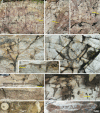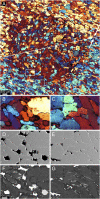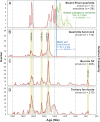Eocene animal trace fossils in 1.7-billion-year-old metaquartzites
- PMID: 34580219
- PMCID: PMC8501772
- DOI: 10.1073/pnas.2105707118
Eocene animal trace fossils in 1.7-billion-year-old metaquartzites
Abstract
The Paleoproterozoic (1.7 Ga [billion years ago]) metasedimentary rocks of the Mount Barren Group in southwestern Australia contain burrows indistinguishable from ichnogenera Thalassinoides, Ophiomorpha, Teichichnus, and Taenidium, known from firmgrounds and softgrounds. The metamorphic fabric in the host rock is largely retained, and because the most resilient rocks in the sequence, the metaquartzites, are too hard for animal burrowing, the trace fossils have been interpreted as predating the last metamorphic event in the region. Since this event is dated at 1.2 Ga, this would bestow advanced animals an anomalously early age. We have studied the field relationships, petrographic fabric, and geochronology of the rocks and demonstrate that the burrowing took place during an Eocene transgression over a weathered regolith. At this time, the metaquartzites of the inundated surface had been weathered to friable sandstones or loose sands (arenized), allowing for animal burrowing. Subsequent to this event, there was a resilicification of the quartzites, filling the pore space with syntaxial quartz cement forming silcretes. Where the sand grains had not been dislocated during weathering, the metamorphic fabric was seemingly restored, and the rocks again assumed the appearance of hard metaquartzites impenetrable to animal burrowing.
Keywords: Eocene; Paleoproterozoic; geochronology; regolith; trace fossils.
Conflict of interest statement
The authors declare no competing interest.
Figures






References
-
- Thom R., “The evolution of Proterozoic rocks near the Fraser Front at Ravensthorpe, Western Australia,” Ph.D. thesis, Imperial College, University of London, London (1977).
-
- Runnegar B., The Cambrian explosion: Animals or fossils? J. Geol. Soc. Aust. 29, 395–411 (1982).
-
- Seilacher A., Bathymetry of trace fossils. Mar. Geol. 5, 413–428 (1967).
-
- MacEachern J. A., et al. ., “The ichnofacies paradigm” in Trace Fossils as Indicators of Sedimentary Environments, Knaust D., Bromley R. G., Eds. (Elsevier, 2012), pp. 103–138.
Publication types
MeSH terms
LinkOut - more resources
Full Text Sources

